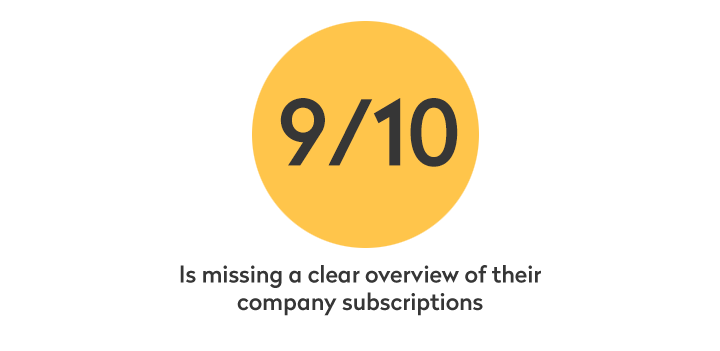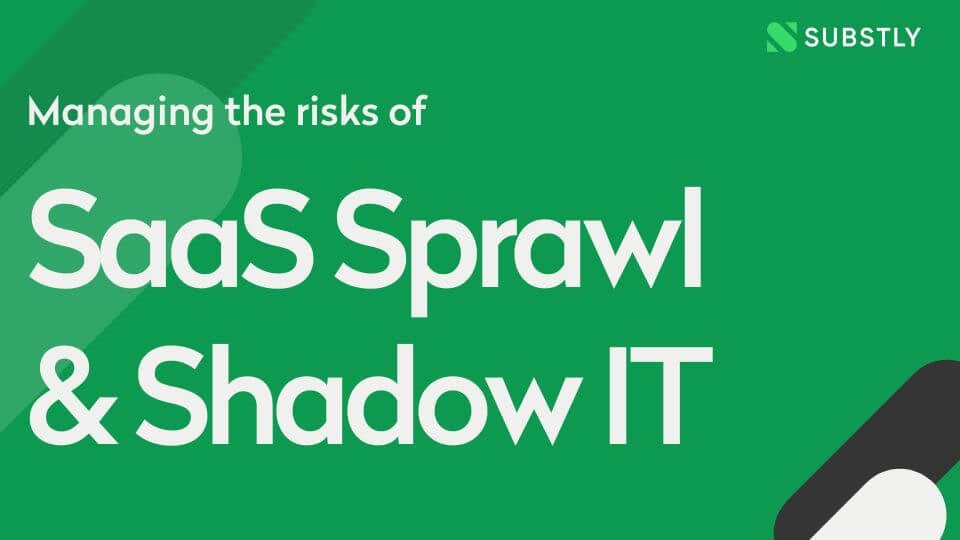As the need for new digital tools increases, the company's cloud-based services quickly become impossible to manage – especially as the team grows.
New challenges require new digital tools, often requiring you to sign up for a new business subscription. But what will happen with the subscriptions when the challenge is complete? – Who was the user, what was the password, and why was the tool used? About a third of companies' digital services are unused because of the lack of a clear overview.
Excel does an excellent job handling business subscriptions, but today's business world is far too complex and challenging to rely solely on spreadsheets. In addition, many of today's decision-makers state that they are already drowning in Excel sheets. This whitepaper presents five reasons to stop using spreadsheets to manage your subscription-based services.
1. Get a better overview
Almost all companies in all industries rely on digital subscription services to handle their daily tasks. It's no longer just marketing and IT. In HR, finance, and accounting, companies are also increasingly moving from paper-based processes to cloud-based solutions to handle their tasks more efficiently. But the perceived efficiency often has a downside. When subscription services are stacked on top of each other, there is a risk of losing control. The spreadsheet's weakness becomes apparent – the information becomes too complex and confusing to handle.

Different owners for each digital service make it impossible to overview the spend and who uses what service. It's easy to lose track of your business subscriptions – especially as your team grows and new services are acquired. Each new service involves an additional payment cycle to manage. Gathering everything that affects company subscriptions in one place brings many benefits and gives you that wonderful feeling of total control. It facilitates internal processes and increases visibility, freeing time for employees.
With a clear overview of your digital services, you can:
- Find out how much of your budget you on subscriptions and other cloud services.
- Discover potential security risks and understand which digital services imply the most significant risks.
- Identify any overlap between services used within the company to see if consolidation is possible.
2. User management – who is using what?
Once you have identified all the digital services available in the organization and their costs, the next step is to identify their users and renewal dates. Considering costs and user values enables a more informed decision about which applications should be renewed. By gathering information, you can get help to avoid unnecessary expenses and subscription renewals.

3. Manual work equals time and time equals money
Using Excel to manage your cloud-based services, you probably already know how frustrating it can sometimes be. It is impossible to get a complete overview and maintain this as new digital subscriptions constantly are added, replaced, or renewed within the organization. A manual work tool like Excel relies on frequent updates from your team. If their usage has changed or the service has been added or removed, it is up to them to report it. The chance that information falls between the cracks is high.
Being free of cost and the short starting distance often indicates using Excel. However, this does not reflect the actual price. It represents a considerable amount of time only to maintain and operate such a dispersed process as the management of cloud-based services. Keeping relevant data up to date for budgeting and manual reporting is time-consuming. As decision-making becomes increasingly collaborative and the workforce becomes more distributed and global, keeping spreadsheets up to date, emailing them to colleagues, manually feeding in updates and resubmitting them is far too time-consuming and inefficient.
The more complex tasks to handle, the greater the probability of human error. Research indicates that more than 90% of spreadsheets contain errors, and half of the spreadsheet models used in large companies have "material defects." The creator of the Excel sheet often has limited control over those who edit specific cells.
4. Duplicate Apps, Duplicate Costs
About a third of companies' digital services are unused. One-third of one's digital services involve a large amount of money for most companies. Google Workspace licences alone can get costly, as many are left unused. For a company with 50 employees, this can mean unnecessary costs of 3090 EUR annually on their Google Workspace subscriptions alone. (based on stats from Cleanshelf, 62 EUR per person) Still, a third remains an evidence-based number to relate to. How can that be?
The answer to the question lies in how digital subscriptions are presented. No one would raise an eyebrow at the image of a subscription lined up in a field in an old Excel file. Other tools are required to perceive the total cost and get a clear picture of one's digital services. Tools that first show which subscriptions are used and, secondly, present the statistics clearly and appealingly.

To keep track of your costs, you need to:
- Know where the money goes
- Make sure those costs are necessary
- Find ways to reduce costs
But this, in turn, requires answers to the following questions:
- How much do you currently spend on digital services?
- What services are purchased?
- Who uses each application?
- Are there any redundant services or recurring costs?
Companies need a tool that constantly scans and examines the digital business environment. With the help of easy-to-read dashboards and reports, a tool that reveals duplicates of underutilized and unauthorized applications. Transparency is the only way today's companies can regain control of their digital services.
5. Say goodbye to excel sheets once and for all
Underutilized or unused digital services are a cost issue and are also something that affects security. As many as 71% of organizations today have subscriptions without an invoicing owner. This may imply that the person who purchased the specific service left the organization.
Additionally, today's compliance and control environment mean that locked cells and password-protected sheets are insufficient and directly weak. Spreadsheets can quickly disappear or become compromised in other ways.
So what is the solution?
How can your organization make the best decisions about digital services and usage when forced to make decisions based on incomplete or incorrect information? You can take control using a subscription management system.
Substly was built to help companies overcome these challenges by providing a cost-effective way to regain control of their digital services and subscriptions. Substly gives you the overview you always wanted without even knowing about it. Say goodbye to spreadsheets once and for all and move on to modern management of digital services.
Related articles
SaaS Management: What is it, tips for getting started & best practices
Get an overview of your company´s recurring costs - Subscription management for CEOs
When should you invest in a SaaS management platform?





